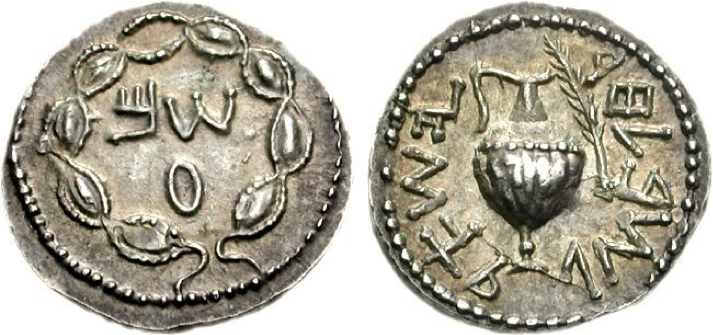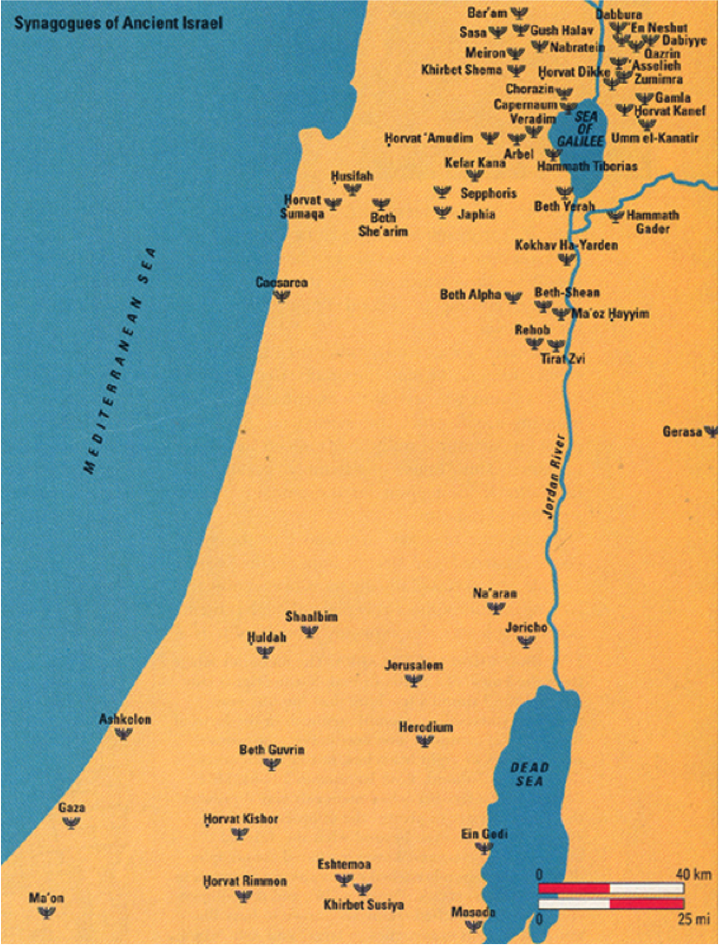100 - 200 CE
Rabbinic Judaism
Magdala Synagogue, Photo by Ardon Bar-Hama
Theodotos Inscription
The Earliest Known Inscription from a Synagogue, located just South of the Temple Mount, 1st-3rd Century CE
“Theodotos son of Vettenus, priest and head of the synagogue (archisynágōgos), son of a head of the synagogue, and grandson of a head of the synagogue, built the synagogue for the reading of the law and for the teaching of the commandments, as well as the guest room, the chambers, and the water fittings as an inn for those in need from abroad, the synagogue which his fathers founded with the elders and Simonides.”
Synagogues were informal meeting places, where the predominant religious activity seems to have been the study of Torah. The Temple and synagogue had complementary functions; only later, after the Temple’s destruction, did the synagogue come to be, in the words of an ancient rabbi, a “small temple”—though with less holiness than the eternally sacred Temple of Jerusalem.

Israel Museum / Israel Antiquities Authority
Roman Emperor Hadrian, r. 117 - 138 CE
Hadrian visited Jerusalem in 130 CE. He rebuilt Jerusalem from the wreckage as a Roman colony and renamed it ”Aelia Capitolina.”
Aelia came from Hadrian's nomen gentile, Aelius, while Capitolina meant that the new city was dedicated to Jupiter Capitolinus, to whom a temple was built on the Temple Mount.
Bust of Hadrian found in Israel by a tourist looking for coins
Israel Museum / Israel Antiquities Authority
Hadrian Builds a Temple of Jupiter on on the Site of the Second Temple, 130 CE
Cassius Dio, Roman History 69.12
“At Jerusalem he [Hadiran] founded a city in place of the one which had been razed to the ground, naming it Aelia Capitolina… on the site of the temple of the (Israelite) god he raised a new temple to Jupiter.”
Coin Depicting Temple of the Capitoline Triad: Minerva, Jupiter, Juno with the Inscription “Colony Aelia Capitolina.” Struck in Jerusalem c. 130 AD

The Bar Kokhba Revolt to Re-establish Israel, 132-135 CE
Coin from the Bar Kokhba Revolt, Year 2:
“Year two of the freedom of Israel.”
After Hadrian renamed Jerusalem and built the Temple of Jupiter, Rabbi Akiva and Simon Bar Kokhba led a revolt from 132-135 CE against the Romans. During this war, the Romans murdered 500,000 Israelites.
Coin from the Bar Kokhba Revolt, year 3:
“For the Freedom of Jerusalem.”
This coin shows the lulav and etrog imprinted over the face of Emperor Vespasian. The reverse shows the Temple with the Ark of the Covenant and the showbread table as they remembered it.
Collection of George Blumenthal, Photo by Ardon Bar-Hama
Bar Kokhba Requests the Lulav and Etrog to Celebrate Sukkot, the Festival of the Harvest, 133 CE
Exodus 23:16
“Celebrate the Festival of Harvest with the first fruits of the crops you sow in your field. Celebrate the Festival of Ingathering at the end of the year, when you gather in your crops from the field.”
Bar Kokhba Letter
“Send wooden beams (lulavs) and citrons (etrogs) for the celebration of Sukkot.”

Israel Museum, Jerusalem / Israel Antiquities Authority

Locations of Ancient Synagogues that have been Discovered
More than 150 ancient Synagogues, mostly in the Galilee, have been discovered in the Land of Israel, dating from the 1st Century CE.
Biblical Archaeological Society
Photo by Ardon Bar-Hama
Revolt Against Roman Emperor Trajan, 115 – 117 CE
The Kitos War was a second Jewish-Roman War initiated in large Jewish communities of Cyprus, Cyrene (modern Libya), Aegipta (modern Egypt) and Mesopotamia (modern Syria and Iraq). It led to mutual killing of hundreds of thousands Jews ending with a total defeat of Jewish rebels and complete extermination of Jews in Cyprus and Cyrene by the newly installed Emperor Hadrian.
Archaeological Park Xanten
created with
WordPress Website Builder .